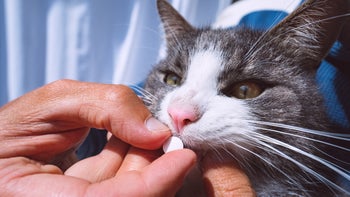
14 Reasons Your Cat May Be Drooling
Key takeaways:
It’s normal for cats to drool sometimes, particularly when they feel relaxed, excited, or happy.
A sudden increase or shift in your cat’s drooling could indicate a health issue.
Seek veterinary care if your cat drools excessively or shows other symptoms, like loss of appetite, vomiting, diarrhea, or difficulty breathing.
Table of contents

Has your cat ever surprised you with a drool session during a cozy cuddle? Imagine the purring and kneading, and a little drool might slip out. Sometimes, cats drool when they are at their happiest and most relaxed.
But drooling isn’t always a sign of contentment. Cats may drool when feeling sick. Understanding why your cat is drooling can help you care for them.
Why is my cat drooling?
Cats drool for many reasons, from relaxation to serious health problems. Read about some causes of drooling. But contact your veterinarian if your cat is drooling excessively or with other symptoms. This could indicate a health condition that needs treatment.
Search and compare options
1. Happiness and contentment
Some cats drool when they feel happy, excited, or relaxed. Many pet parents have experienced this firsthand. Minor drooling when your cat is purring, is anticipating a treat, or even while sleeping is not usually cause for concern.
2. Bitter medication taste
Cats might drool when they taste something unpleasant, like a bitter-tasting medication. A cat’s mouth might naturally respond by producing excess saliva to wash away the unpleasant taste.
3. Pain
Cats who are in pain may drool. A number of health conditions can cause pain in cats. These include:
Injuries
Pancreatitis
Mouth pain
4. Fear
Fear is another reason cats may drool. Other signs your cat may be stressed or anxious include:
Body language that makes them look smaller
Hiding
Aggression
Overgrooming
Not using the litter box
Dilated pupils
Trembling
Panting
Meowing more than usual
5. Dental disease
Dental disease in cats can cause mouth pain, inflammation, and excessive drooling. Several types of dental conditions can lead to drooling, such as:
Gingivitis
Periodontitis
An oral abscess
Cat fears: Can you recognize all the signs your cat may be afraid, stressed, or anxious? Review this list to see if there are any you may have missed.
Me-Ouch: Cats can be good at hiding their pain. But once you learn to see these common feline pain symptoms, you’ll be ready to help your cat feel better sooner.
Human medicines for pets: Cats can take some of the same medications as humans. Here’s how to fill these prescriptions for your pet.
Studies suggest that up to 90% of cats have dental disease at some point. Cats with oral health issues might also show other symptoms, including:
Difficulty eating
Bad breath
Bleeding in or from the mouth
6. Upper respiratory infection
Your cat may drool if they have a respiratory infection. Two common infections in cats are feline viral rhinotracheitis and feline calicivirus.
Cats with a respiratory infection often have other symptoms, such as:
Runny nose
Eye discharge
Congestion
Sneezing
Coughing
7. Foreign objects or mouth injury
Cats are curious creatures. They may investigate objects with their mouths and swallow something they shouldn’t. Notice if your cat is drooling, gagging, or regurgitating or has trouble swallowing. If so, they may have a mouth injury, or a foreign object may be stuck in their digestive tract.
8. Upset stomach
Sometimes, cats drool when they have an upset stomach. Nausea or vomiting can be caused by several things, such as:
Eating something they shouldn’t
Food allergies
Digestive issues
Medication side effects
9. Exposure to a poison
Drooling, vomiting, fever, and diarrhea are common poisoning symptoms in cats. Cats can be exposed to poisons or toxic substances in three ways: eating, breathing, or absorbing them through their skin, especially their paws.
For instance, the inviting smell of lilies might attract some felines, prompting them to take an exploratory nibble. Lilies are beautiful flowers, but they are toxic to cats. In addition to drooling, cats who ingest lilies may vomit, not want to eat, and develop kidney failure.
If your cat encounters a poisonous substance, contact your veterinarian immediately. You can also call a pet poison hotline for advice on what to do.
10. Rabies
Rabies is a less common reason cats may drool. If your cat spends a lot of time outdoors, they may encounter a wild animal infected with rabies. Raccoons, skunks, foxes, and bats are common carriers of the rabies virus.
Symptoms of rabies in cats may include:
Drooling
Aggression
Changes in behavior
Loss of muscle control
In recent years, cats have become the most common domestic animals infected with rabies. To protect your cat, ensure they receive the feline rabies vaccine. You can also lower your cat’s risk for rabies by keeping them indoors.
11. Heatstroke
While heatstroke is less common in cats than dogs, drooling can be a symptom. Other symptoms of heatstroke may include:
Skin that’s hot to the touch
Panting
Restlessness
Fever
Overweight or flat-faced cats may be more prone to heatstroke.
12. Oral cancer
Oral cancer may cause cats to drool. The most common oral cancer in cats is feline oral squamous cell carcinoma. Oral cancer is the fourth most common type of cancer in cats overall, affecting up to 20% of cats.
In addition to drooling, signs of oral cancer in cats may include:
Bad breath
Facial swelling
Difficulty swallowing
13. Feline stomatitis
Feline stomatitis is a condition that causes severe inflammation in the deep tissues of a cat’s mouth. Excessive drooling is a common sign, especially if the saliva appears thick or tinged with blood.
14. Liver disease
Complications of feline liver disease may include conditions like hepatic encephalopathy and hepatic lipidosis. These are both linked to excessive drooling in cats.
When should you see a vet about cat drooling?
If you notice your cat’s drooling is excessive or they have other symptoms, contact your veterinarian immediately. Additional symptoms to look out for along with drooling include:
Poor appetite
Vomiting
Diarrhea
Difficulty breathing
Trouble swallowing
Also seek urgent medical attention if you suspect your cat has been exposed to a toxic substance or has had a seizure. These are all emergencies.
The bottom line
It’s not unusual for cats to drool a small amount, particularly when your cat is purring, sleeping, or excited. But drooling in cats can be a sign of an underlying health issue. Possible causes include dental disease, nausea, upper respiratory infections, or a more serious condition like oral cancer.
Seek immediate veterinary care if your cat’s drooling is excessive or paired with other symptoms like vomiting, loss of appetite, or trouble breathing. Regular veterinary check-ups and dental care can help prevent some health issues that lead to drooling. Stay attuned to changes in your cat’s behavior. If you notice anything unusual, don’t hesitate to consult a veterinarian. After all, you are your cat’s best advocate.
Why trust our experts?



References
American Veterinary Medical Association. (n.d.). Rabies.
Bellows, J., et al. (2016). Periodontal disease in dogs and cats. Veterinary Partner.
Bellows, J., et al. (2016). Stomatitis in cats. Veterinary Partner.
Bellows, J. (2019). Dental care in cats. Veterinary Partner.
Center, S. A. (2024). Disorders of the liver and gallbladder in cats. Merck Veterinary Manual.
Cornell Feline Health Center. (n.d.). Oral cavity tumors. Cornell University College of Veterinary Medicine.
Cornell Feline Health Center. (n.d.). Poisons. Cornell University College of Veterinary Medicine.
Cornell Feline Health Center. (2017). Feline dental disease. Cornell University College of Veterinary Medicine.
Gfeller, R., et al. (2025). Hyperthermia (heat stroke): First aid. Veterinary Partner.
Hall, B. P. (2014). Clinical signs of oral or dental disease in pets. Veterinary Partner.
Keuhn, N. F. (2024). Feline respiratory disease complex (feline viral rhinotracheitis, feline calicivirus). Merck Veterinary Manual.
Mazzaferro, E. (2015). Treatment of hyperthermia and heat-induced illness. World Small Animal Veterinary Association World Congress Proceedings.
Mulherin, B. L. (2024). Salivary disorders in small animals. Merck Veterinary Manual.
Neer, T. M. (2024). Motion sickness in cats. Merck Veterinary Manual.
Reiter, A. M. (2024). Disorders of the mouth in cats. Merck Veterinary Manual.
Rupprecht, C. E. (2024). Rabies in cats. Merck Veterinary Manual.
Seksel, K. (2014). Stress and anxiety - how do they impact the pet? World Small Animal Veterinary Association World Congress Proceedings.
Sequeira, I., et al. (2022). Feline oral squamous cell carcinoma: A critical review of etiologic factors. Veterinary Sciences.
Walters, P. (2024). Disorders of the esophagus in cats. Merck Veterinary Manual.
Webb, C. B. (2024). Vomiting in cats. Merck Veterinary Manual.

























